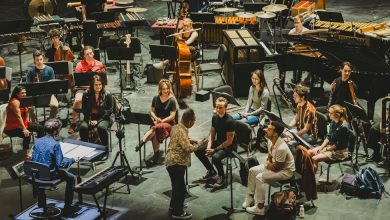Exploring the Dimensions of Black Power at Alvin Ailey

At Alvin Ailey American Dance Theater, Black lives have always mattered. But these days, the company’s repertory has more to say about it or perhaps a different way of saying it, with a deeper urgency and radiance — and dancing that seems to be crying for a kind of freedom. “Revelations,” Ailey’s 1960 classic, still closes many of the company’s programs, but does it have to? What if, as an experiment, the company started the show with “Revelations”? And what better time than now, when audiences are so grateful for live performance, to shake things up?
The company’s repertory, which has improved during the tenure of the artistic director, Robert Battle, allows for more choices. Ailey didn’t open its season Wednesday at New York City Center with “Lazarus,” by the hip-hop master Rennie Harris, but it should have. The opening was a gala affair on Wednesday, ending with, of course, “Revelations.” The sobering and gorgeous “Lazarus,” on Thursday, was even more spellbinding as it explored the systemic oppression of Black people that began centuries ago and continues today.
Has “Lazarus” become more potent and raw? Is it more relevant given the dramatic events that have occurred — the murder of George Floyd and the wave of uprisings in 2020 that demanded an end to police violence against people of color — since its premiere in 2018? Yes and yes and more yes.
Bearing witness to “Lazarus” was more than experiencing another reunion of a dance company that had been put on hold by the pandemic. The company delivered a performance in which dance became something else: a release, somehow both stirring and settling. The dancers, with their blistering footwork, sliced up the stage. It’s a shame that because of pandemic-related safety issues, this season is shorter than usual: “Lazarus” is scheduled for only one more performance, on Dec. 16.
On Friday night, along with “Revelations” — the crowd roared throughout, even though the performances weren’t as well-oiled as usual — the company presented premieres by Battle and its resident choreographer, Jamar Roberts. Both pieces were released as digital works during the pandemic; this was their first time onstage with a live audience.
Roberts’s “Holding Space,” named for the empathetic action of being present for another person, also refers to its architecture. The cast members, arranged in rows, perform in solitary squares. When Roberts was choreographing the work, there were safety protocols in place requiring dancers to be six feet away from one another. For the first part of “Holding Space,” this is evident: The tense opening movements comprise a web of arms and legs — flinging, reaching, twisting — within invisible walls.
The discordant music, by Tim Hecker, along with Brandon Stirling Baker’s otherworldly lighting — bright white, icy blue and, later, a golden amber — creates a sci-fi feel as dancers escape their confinement to drift into solos. A cube appears; inside, the dancer Jacqueline Green stretches and contorts her long limbs with sculptural ease, as well as what seems to be a yearning to escape: With a flexed foot, she stretches a leg in front of her torso and arches back — a test not only of her balance, but also of her daring and resolve.
When Green exits the cube, others take her place, last of all Yannick Lebrun, who pushes against phantom forces, lurching his torso forward and back and opening his arms like wings. When he comes out of the structure, James Gilmer touches him on his back and takes over the dance; here, the lighting switches to amber and the music gives way to silence.
For this solo — an addition, and a good one, to the virtual version — Gilmer, showing the flexibility in his strength, allows the movement to soften as it flows through his bones. His change of shirt indicates a transformation as well: Before, the dancers’ tops featured a structured edge between the shoulder and the sleeve. Now they’re soft, and the dancing follows suit — no longer hard and angular, the choreography floats along now as a vehicle for tenderness and healing.
Certainly, in look and in choreography, Roberts, also credited with scenic and costume design, has created something stylish. But is it lasting? “Holding Space” ends up in the category of a pandemic dance — not only for its spatial arrangement, but for its themes of isolation, confinement and, ultimately, transformation. While it has beautiful moments — Gilmer’s solo, especially — it feels anchored to a period of time and its constrictions without being particularly revelatory as a work of art. Battle’s “For Four,” a snazzy seven or so minutes set to music by Wynton Marsalis, is more surprising. It’s light and buoyant — or so it seems.
In it, the dancers — Renaldo Maurice, Solomon Dumas, Belén Indhira Pereyra and Samantha Figgins — hit the musical notes with their bodies. They hit hard. Their wild energy, alluring at first, becomes frenetic, almost manic over time; are they having fun or are they desperate? Despite the dancers’ showbiz smiles, sequined overalls and clapping hands, “For Four” has something ominous simmering beneath its surface.
It’s a sprint to make it to the finish line: Dumas is electrifying, feverish, while Figgins is a vision of lithe fluidity. Pereyra’s perpetual swirl of motion is only boosted by her whipping, bountiful hair — never has hairography been so delightful. When, suddenly, an American flag is projected onto the back of the stage, Maurice, shirtless, collapses to the floor; the projection slides to the floor, too, where bits of red seem to spread over his skin like blood.
When the final notes play and the dancers stand calmly at the back of the stage, each with a raised fist salute, Maurice rolls on the floor in the shape of an opened fan — or a needle spinning on a record. “For Four” isn’t just about the need to dance amid a pandemic: It’s a frantic fight for freedom of body and mind.
Alvin Ailey American Dance Theater, through Dec. 19, New York City Center, Manhattan; nycitycenter.org



